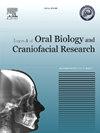类风湿关节炎患者和健康人的口腔健康状况和唾液特征的相关性以及用口腔造影预测龋齿风险的横断面分析研究
Q1 Medicine
Journal of oral biology and craniofacial research
Pub Date : 2025-03-31
DOI:10.1016/j.jobcr.2025.03.020
引用次数: 0
摘要
背景:类风湿性关节炎(RA)是一种主要影响关节的持续性炎症。然而,它也会影响口腔健康,包括颞下颌关节异常、牙周病和口干症。尽管存在这些相关性,但很少有证据表明类风湿性关节炎与牙齿健康的某些标志物有关。本研究的目的是通过评估RA患者的唾液特征和口腔健康状况来缩小这一差距。目的评价和比较类风湿关节炎患者与健康对照者的唾液和口腔健康状况。ObjectivesTo evaluate.1。使用世卫组织指南的牙周健康和龋齿经验——《成人口腔健康形式》(2013年)使用唾液检测试剂盒测定唾液参数。3 .基于牙谱的龋齿风险评估。类风湿关节炎与口腔健康的关系方法共招募了90名志愿者,其中47名是年龄匹配的健康人,43名是类风湿关节炎患者。数据收集过程采用结构化问卷、临床评估和唾液采集。使用世卫组织成人口腔健康评估表(2013年)评估牙齿健康,并监测唾液流速和pH值。减少龋齿模型用于评估龋齿风险。采用SPSS version 22进行统计分析,显著性设为p <;0.05.结果与对照组相比,RA患者龋齿发生率、牙龈出血发生率和牙周袋深度均显著增高(p <;0.05)。RA患者还表现出唾液pH值降低,受刺激和未受刺激的唾液流速降低。唾液流量与牙袋深度、牙龈出血和龋齿呈负相关。此外,龋齿图显示患有关节炎的患者龋齿的发病率更高。结论类风湿关节炎对口腔健康有不良影响。类风湿性关节炎患者患龋齿和牙周炎的比例较高,可能是由于唾液功能受损。这些结果强调了对类风湿关节炎患者进行彻底的口腔健康评估和定制预防方法的重要性,以减少口腔健康问题。本文章由计算机程序翻译,如有差异,请以英文原文为准。
Association of oral health status and salivary profile of rheumatoid arthritis disease subjects and healthy subjects and prediction of caries risk using cariogram- A cross-sectional analytical study
Background
Rheumatoid arthritis (RA) is a persistent inflammatory condition that predominantly affects the joints. However, it also affects the oral health, including temporomandibular joint abnormalities, periodontal disease, and xerostomia. Although these correlations exist, there is little proof that RA is associated with certain markers of dental health. The purpose of this study is to close this gap by assessing the salivary profile and oral health status of RA patients.
Aim
To assess and contrast the salivary profile and oral health status of people with rheumatoid arthritis with that of healthy controls.
Objectives
To evaluate.
1. Periodontal health and caries experience using WHO guidelines Adult oral health proforma (2013)
2. Salivary parameters using a salivary kit.
3. Cariogram-based assessment of caries risk.
4. Association between Rheumatoid arthritis and Oral health.
Methods
A total of ninety volunteers were enrolled, forty-seven of whom were age-matched healthy individuals and forty-three of whom were patients with rheumatoid arthritis. A structured questionnaire, clinical assessment, and saliva collection were used in the data gathering process. Dental health was evaluated using the WHO Oral Health Assessment Form for Adults (2013), and salivary flow rate and pH were monitored. The Reduced Cariogram model was used to assess the risk of caries. SPSS version 22 was used for the statistical analysis, with significance set at p < 0.05.
Results
Compared to controls, those with RA had significantly higher rates of dental caries, more gingival bleeding, and deeper periodontal pockets (p < 0.05). Patients with RA also showed decreased salivary pH and decreased stimulated and unstimulated salivary flow rates. Salivary flow rates were found to be negatively correlated with pocket depth, gingival bleeding, and dental caries. Furthermore, the Cariogram showed that patients with arthritis had a higher incidence of dental caries.
Conclusion
The findings suggest that dental health is negatively impacted by rheumatoid arthritis. Patients with RA have a higher prevalence of dental caries and periodontitis likely due to impaired salivary profile. These results highlight the significance of thorough oral health evaluations and customized preventive methods for people with rheumatoid arthritis in order to lessen oral health issues.
求助全文
通过发布文献求助,成功后即可免费获取论文全文。
去求助
来源期刊

Journal of oral biology and craniofacial research
Medicine-Otorhinolaryngology
CiteScore
4.90
自引率
0.00%
发文量
133
审稿时长
167 days
期刊介绍:
Journal of Oral Biology and Craniofacial Research (JOBCR)is the official journal of the Craniofacial Research Foundation (CRF). The journal aims to provide a common platform for both clinical and translational research and to promote interdisciplinary sciences in craniofacial region. JOBCR publishes content that includes diseases, injuries and defects in the head, neck, face, jaws and the hard and soft tissues of the mouth and jaws and face region; diagnosis and medical management of diseases specific to the orofacial tissues and of oral manifestations of systemic diseases; studies on identifying populations at risk of oral disease or in need of specific care, and comparing regional, environmental, social, and access similarities and differences in dental care between populations; diseases of the mouth and related structures like salivary glands, temporomandibular joints, facial muscles and perioral skin; biomedical engineering, tissue engineering and stem cells. The journal publishes reviews, commentaries, peer-reviewed original research articles, short communication, and case reports.
 求助内容:
求助内容: 应助结果提醒方式:
应助结果提醒方式:


